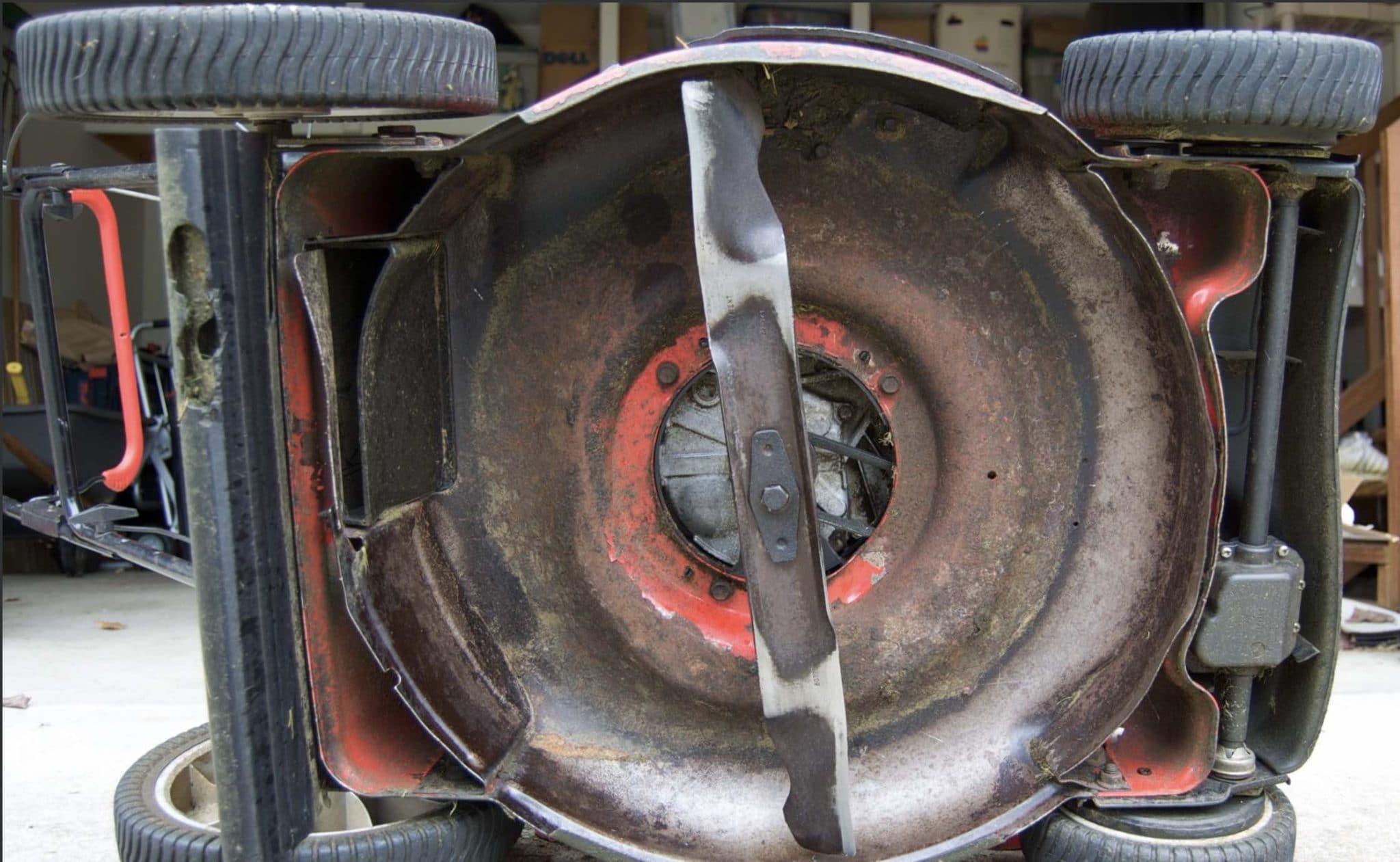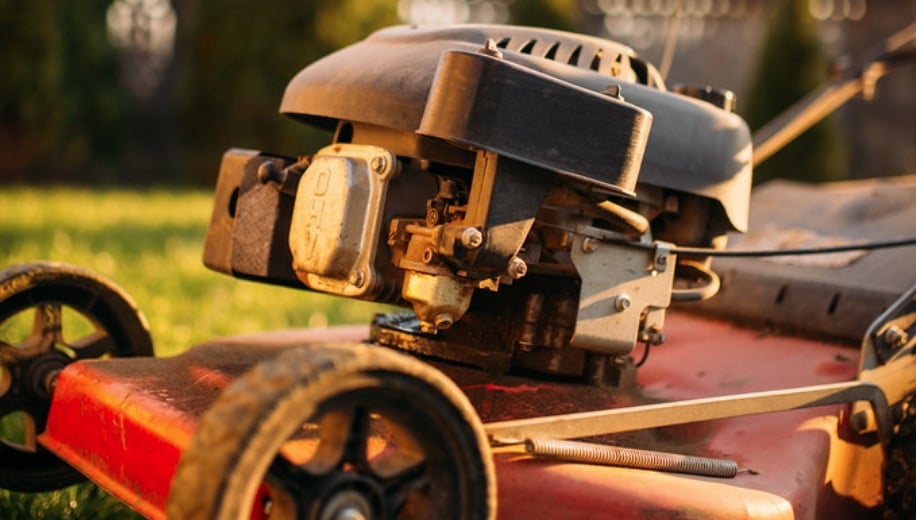Initial Lawn Mower Inspection
Before the mowing season kicks off, a thorough inspection of your lawn mower ensures it operates smoothly and efficiently.
Addressing the basics can prevent mid-season breakdowns and maintain your equipment in peak condition.
Check Engine Oil Level
- Pull out the dipstick and wipe it clean.
- Insert it back fully, remove it again to check the oil level.
- If it’s low, top it off; if it’s dirty or has been a while since the last change, it’s time for an oil change.
Inspect Spark Plugs
- Locate and remove the spark plug using a spark plug socket.
- Examine it for wear or damage; look for a tan-colored electrode.
- A damaged or overly dirty spark plug should be replaced to ensure easy starts and proper engine operation.
Examine Air Filter
- Gently remove the air filter and hold it up to light.
- If light doesn’t pass through or it’s noticeably dirty, replace it.
- A clean filter is crucial for engine performance and life span.
Assess Fuel System
- Check the fuel level and consider if the gas is fresh – stale fuel can cause issues.
- Inspect the fuel lines for cracks or leaks.
- A well-maintained fuel system contributes to easy starts and consistent power.
Cleaning and Blade Care
To ensure your lawn mower runs smoothly through the mowing season, focus on thorough cleaning and keeping the blades in top condition.
Clean the Mower Deck
- Remove Debris: Before starting, disconnect the spark plug wire for safety.
- Use a putty knife or similar tool to scrape off grass and debris from the underside of the deck.
- Accumulated clippings can hinder performance and cause rusting.
- Wash Thoroughly: After scraping, wash the deck with a strong stream of water.
- For non-metal parts, a damp cloth with mild detergent will do. Make sure to remove any soap residue with a clean cloth to prevent corrosion.
Sharpen or Replace Blades
- Inspect Blades: Check your mower’s blades for any signs of dullness or damage.
- Dull blades tear grass, resulting in a ragged edge that makes your lawn more susceptible to diseases.
- Sharpening: If the blades are dull but undamaged, sharpen them using a file or a blade-sharpening tool following the blade’s original angle.
- Wear gloves and handle the blades with care to avoid injury.
- Replacement: Should the blades be beyond sharpening, replace them with new ones.
- Always use blades that are recommended by your mower’s manufacturer to maintain optimal performance.
Battery and Electrical Systems
Ensuring your lawn mower’s battery and electrical systems are in prime condition is crucial for a hassle-free mowing season.
Charge or Replace Battery
- Check the Charge: Begin by checking your lawn mower’s battery charge.
- A voltmeter can help determine if it’s at the optimal level, which usually stands at 12.7 volts or above for a fully charged battery.
- Battery Maintenance: If the charge is low, use a trickle charger to slowly bring the battery up to full capacity.
- This avoids overcharging and extends battery life.
- Consider Replacement: Batteries typically last a few years.
- If yours isn’t holding a charge even after proper charging, it might be time to replace it.
Test Ignition System
- Check Connections: Make sure all connections to the ignition are secure and free of corrosion.
- Clean any corroded terminals with a wire brush.
- Spark Plug Inspection: Remove the spark plug and look for corrosion or deposits.
- Replace it if it’s worn out to ensure reliable ignition.
- Start-Up Test: After maintenance, start your mower to test the ignition system.
- It should fire up smoothly if all components are working properly.
Lubrication and Tightening
Proper lubrication and tightening are essential for your lawn mower’s performance and longevity.
These steps reduce wear and prevent mechanical failures, ensuring your mower runs smoothly throughout the season.
Lubricate Moving Parts
- Check the manual: Your lawn mower’s manual will list all the lubrication points specific to your model.
- Apply grease: Use a grease gun to apply lubricant to parts such as wheel bearings, spindles, and any other moving components outlined in your manual.
-
- Ensure that you wipe away any excess grease to maintain cleanliness and prevent debris buildup.
Tighten Loose Bolts and Fasteners
- Inspection: Carefully inspect your mower to identify any bolts, nuts, or fasteners that have become loose over time.
- Tighten carefully: Use the correct size wrench or socket to tighten these elements.
- Avoid over-tightening to prevent thread stripping.
- Fastener tightness should be just right to hold parts securely without damaging them.
Belt and Drive System Maintenance
When spring arrives, ensuring your lawn mower operates smoothly is crucial.
The belt and drive system are key components that require thorough inspection and adjustment for optimal performance.
Inspect Drive Belts
- Visual Inspection: Check for cracks, wear, and fraying on the drive belts. If any signs of damage are visible, it’s time for a replacement.
- Flexibility Test: Gently bend the belt to ensure it hasn’t hardened or lost flexibility. A brittle belt is more prone to snapping under tension.
Adjust Belt Tension
- Consult Your Manual: Always refer to your lawn mower’s user manual for the correct belt tension settings.
-
- Proper Tension Procedure:
- Locate the adjustment mechanism; this is typically a pulley or lever.
- Adjust the tension mechanism as needed to achieve the proper tightness. A belt that’s too tight or too loose can harm the mower’s operation and longevity.
Frequently Asked Questions
As spring rolls in, ensuring your lawn mower is ready to handle the upcoming season is key.
Take a moment to explore common inquiries and their succinct, professional responses to keep your lawn mower in top condition.
What steps are involved in a lawn mower spring maintenance routine?
- Clean your mower thoroughly, wiping down non-metal surfaces and removing any debris.
- Change the oil and replace the oil filter if equipped.
- Inspect and possibly replace the air filter.
- Check and replace the spark plug if necessary.
- Sharpen or replace the mower blade for a clean cut.
- Lubricate all moving parts, including the wheels and cables.
- Add fresh fuel, possibly with a stabilizer if required.
How often should I replace the spark plug in my lawn mower?
Replace the spark plug once a season or after every 25 hours of lawn mower use. Regular replacement ensures optimal engine performance and efficiency.
What are the signs that a lawn mower blade needs sharpening or replacement?
Look for these indicators:
- Grass blades are torn and not cleanly sliced.
- Mowing unevenness, with some areas cut lower than others.
- Blade has noticeable dents, rust, or is bent.
Is there a specific maintenance checklist to follow for preparing a lawn mower for the upcoming mowing season?
Yes, you can follow a comprehensive maintenance checklist that includes:
- Changing the oil and filter.
- Cleaning or replacing the air filter.
- Inspecting and sharpening the blade.
- Checking all cables and controls.
How can I ensure the optimal performance of my lawn mower’s engine in the spring?
For optimal engine performance:
- Always use fresh gasoline at the start of the season.
- Keep the engine tuned up according to the manufacturer’s specifications.
- Regularly check and maintain the appropriate oil level.
Which parts of a lawn mower should be cleaned or replaced to avoid issues during the spring and summer mowing months?
Pay attention to these parts:
- Air filter: Clean or replace to prevent engine strain.
- Fuel filter: Replace if clogged to ensure smooth fuel flow.
- Spark plug: Change if corroded or dirty for reliable ignition.
- Blade: Sharpen or replace for effective mowing.
Last update on 2025-04-18 / Affiliate links / Images from Amazon Product Advertising API






